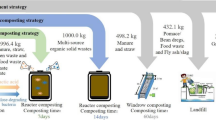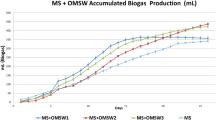Abstract
Methane (CH4) is a greenhouse gas with a global warming potential that is 25 times higher than carbon dioxide (CO2). Microbial oxidation of landfill CH4 is about 5 % and it plays a significant role in reducing emissions to the atmosphere. Previous studies have shown that microbial oxidation of CH4 in landfill cover soil can be enhanced using organic matter-rich substrates. This study aims to investigate the CH4 oxidation activity with the addition of different organic wastes in different combinations. Batch experiments with different organic wastes for CH4 oxidation activity showed that compost and sawdust required the shortest time to oxidize CH4 compared to empty fruit bunch and black soil. However, other organic wastes (spent yeast, sewage sludge and spent tea leaves) tested in this study produced CH4 instead. Compost and sawdust took 4 days for complete CH4 oxidation. Batch experiments with different combinations of organic waste showed potential CH4 reduction when combined with compost. The combination of 20 % spent yeast + 80 % compost was able to completely oxidize CH4 at day 16. CH4 was fully oxidized on day 1 by 20 % sewage sludge + 80 % compost, showing good CH4 oxidation potential; 100 % sawdust fully oxidized CH4 within 4 days, while a combination of 20 % sawdust + 80 % compost and 40 % sawdust + 60 % compost took 2 days for complete CH4 oxidation. From this study, it can be concluded that the addition of organic wastes at optimum ratio and combination with compost as landfill cover material will have a significant effect on CH4 emission reduction.






Similar content being viewed by others
References
Barlaz MA, Green RB, Chanton JP, Goldsmith CD, Hater GR (2004) Biologically active cover for mitigation of landfill gas emissions. Environ Sci Technol 38:4891–4899
Bender M (1992) Mikrobieller Abbau von Methan und anderen Spurengasen in Böden und Sedimenten, Doctoral Thesis at the University of Konstanz, Faculty of Biologie, Hartung Gorre Verlag, pp 1–133
Boeckx P, Cleemput OV, Villaralvo I (1996) Methane emission from a landfill and the methane oxidizing capacity of its covering soil. Soil Biol Biochem 28:1397–1405
Bogner J, Abdelrafie Ahmed M, Diaz C, Faaij A, Gao Q, Hashimoto S, Mareckova K, Pipatti R and Zhang T (2007) Waste management. In: Metz B, Davidson OR, Bosch PR, Dave R, Meyer LA (eds) Climate change: mitigation. contribution of working group III to the fourth assessment report of the intergovernmental panel on climate change. Cambridge University Press, Cambridge, United Kingdom and New York, NY, USA, 1–34
Cabral AR, Moreira JFV, Jugnia LB (2010) Bio cover performance of landfill methane oxidation: experimental results. J Environ Eng 136:785–793
Chanton JP, Liptay K (2000) Seasonal variation in methane oxidation in a landfill cover soil as determined by an in situ stable isotope technique. Global Biogeochem Cycles 14:51–60
Chanton J, Abichou T, Langford C, Spokas K, Hater G, Green R, Goldsmith D, Barlaz MA (2011) Observations on methane oxidation capacity of landfill soils. Waste Manag 31(2011):914–925
Christensen TH, Kjeldsen P, Lindhardt B (1996) Gas-Generating Processes in Landfills, in Landfilling of Waste: Biogas (eds Christensen TH, Cossu R, and Stegmann R) E & FN Spon, London, (ISBN: 0 419 19400), 2: pp 25–50
Fauziah SH (2009) Municipal solid waste management: a comprehensive study in Selangor, Phd Thesis. University of Malaya Kuala Lumpur. 1–591
Fauziah SH, Agamuthu P (2012) Trends in sustainable landfilling in Malaysia, a developing country. Waste Manage Res 30(7):656–663
Fillaudeau L, Blanpain-Avet P, Daufin G (2006) Water, Wastewater and Waste Management in Brewing Industries. J Clean Prod 14(5):463–471
He R, Ruan A, Jiang C, Shen DS (2008) Responses of oxidation rate and microbial communities to methane in simulated landfill cover soil microcosms. Bioresour Technol 99:7192–7199
Hilger H, Humer M (2003) Biotic landfill covers treatments for mitigating methane emissions. Environ Monit Assess 84:71–84
Humer M, Lechner P (1999) Alternative approach to the elimination of greenhouse gases from old landfills. Waste Manage Res 17:443–452
Insam H, Wett B (2008) Control of GHG emission at the microbial community level. Waste Manag 28:699–706
IPCC (2007) Summary for policymakers. In: Solomon S, Qin D, Manning M, Chen Z, Marquis M, Averyt KB, Tignor M, Miller HL (eds) Climate change 2007: the physical science basis Contribution of Working Group I to the Fourth Assessment Report of the Intergovernmental Panel on Climate Change. Cambridge University Press, New York
Isabel CV, Dalcimar RBW, Adao SF, Gilberto FC, Beno W (2010) Microbial and enzymatic activity in soil after organic composting. Secao iii Biologia de Solo 34:757–764
Jayanthi B, Agamuthu P (2011) Enhancement of methane oxidation with effective methanotrophic mixed cultures. Malaysian J Sci 30(1):28–35
Kettunen A (2003) Connecting methane fluxes to vegetation cover and water table fluctuations at microsite level: a modeling study. Global Biogeochem Cycles 17(2):1051
Kightley DB, Nedwell, Cooper M (1995) Capacity for methane oxidation in landfill cover soils measured in laboratory-scale soil microcosms. Appl Environ Microbiol 61(2):592–601
Kjeldsen P (1996) Landfill gas migration in soil. In: Christensen TH, Cossu R, Stegmann R (eds) Landfilling of waste: biogas, E & FN Spon, London, UK, pp 88–132
Lizik W, Im J, Semrau JD, Barcelona MJ (2013) A field trial of nutrient stimulation of methanotrophs to reduce greenhouse gas emissions from landfill cover soils. J Air Waste Manag Assoc 63(3):300–309
Moldes A, Cendon Y, Barral MT (2007) Evaluation of municipal solid waste compost as a plant growing media component by applying mixture design. Bioresour Technol 98:3069–3075
Mor S, Visscher AD, Ravindra K, Dahiya RP, Chandra A, Cleemput OV (2006) Induction of enhanced methane oxidation in compost: temperature and moisture response. Waste Manag 26:381–388
Owolabi O, Adeleye A, Oladeje BT, Ojeniyi SO (2003) Effect of wood ash on soil fertility and crop yield in southwest nigeria. Niger J Soil Sci 13:55–60
Pawloska M (2008) Reduction of methane emissions from landfill by its microbial oxidation in filter bed. In: Pawlowska M et al (eds) Management of pollutant emission from landfills and sludge. Taylor Francis Group, London, pp 3–20
Prant R, Tesar M, Huber Humer M, Lechner P (2006) Changes in carbon and nitrogen pool during in situ aeration of old landfills under varying conditions. Waste Manag 26(4):373–380
Reddy KR, Sadasivam BY (2013) Landfill methane oxidation in soil and bio-based cover systems: a review. Environ Sci Biotechnol J 13:79–107
Ritzkowski M, Heyer KU, Stegmann R (2006) Fundamental processes and implications during in situ aeration of old landfills. Waste Manag 26(4):356–372
United States Environmental Protection Agency (USEPA) (2012) Municipal Solid Waste. Retrieved from http://www.epa.gov/epawaste/nonhaz/municipal/index.html. (Accessed on 5th January 2013)
Wang D, Zhao L, Ping-he Y (2011) Effects of mixed ratio, moisture content, nutrient addition and cover thickness on methane oxidation in landfill bio-cover. Arch Appl Sci Res 3(5):224–232
Wilshusen JHJPA, Hettiaratchi A, De Visscher, Saint-Fort R (2004) Methane oxidation and formation of EPS in compost: effect of oxygen concentration. Environ Pollut 129:305–314
Zamali T, Lazim MA, Abu Osman MT (2009) An overview of municipal solid wastes generation in Malaysia. Universiti Teknologi Malaysia. Journal Teknologi, 51(F): 1–15
Acknowledgments
The authors would like to thank all the individuals involved directly or indirectly in this project for their academic and technical support. We express our utmost appreciation to the University Malaya Research grant (RG143/11SUS), and University of Malaya PPP (PS297/2010B) and (PS298/2010B) for providing research grants to carry out this research.
Author information
Authors and Affiliations
Corresponding author
Rights and permissions
About this article
Cite this article
Pariatamby, A., Cheah, W.Y., Shrizal, R. et al. Enhancement of landfill methane oxidation using different types of organic wastes. Environ Earth Sci 73, 2489–2496 (2015). https://doi.org/10.1007/s12665-014-3600-3
Received:
Accepted:
Published:
Issue Date:
DOI: https://doi.org/10.1007/s12665-014-3600-3




